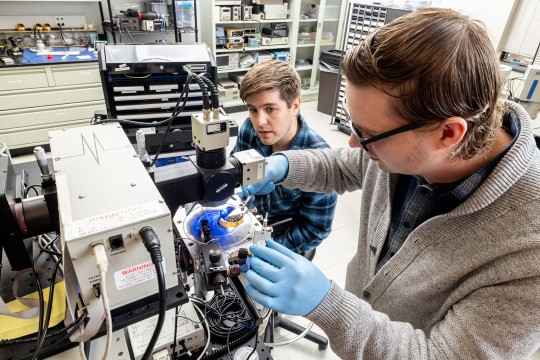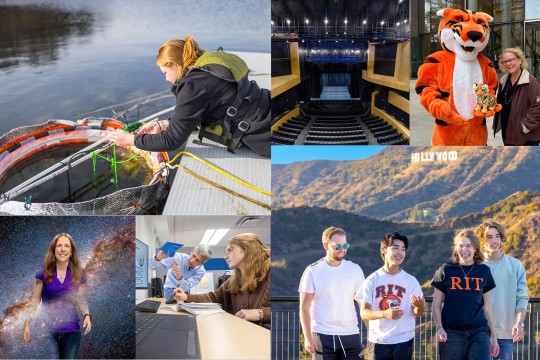STEM degrees, co-ops draw international students
Carlos Ortiz
Lilian Neim, a doctoral student in the microsystems engineering program, works on ring resonators, some of the basic building blocks for photonics devices, to ensure that the power and energy of light is maximized for the chips.
RIT doctoral student Lilian Neim is on the leading edge of research in neuromorphic photonics technology that will make artificial intelligence processing more efficient and higher functioning.
Neim, who is from United Arab Emirates and has earned a master’s degree in engineering from RIT, works closely with her adviser and fellow students in the university’s microsystems engineering Ph.D. program to hone in on her specialty.
She has recognized that the hands-on experiences examining signal processing have the potential to greatly enhance the speed and efficiency of artificial intelligence by utilizing light-based information transfer and neural architectures inspired by the human brain. Her discoveries are made possible due to her commitment to studying this unique aspect of engineering in the United States.
Each year, RIT welcomes nearly 2,000 students from more than 100 countries to its campus. The draw of a top-notch STEM education, along with a nationally ranked co-op and internship program and an increasing global reach with numerous opportunities for programmatic exchanges, gives students the chance for real-world work experiences and career focus, according to Megan Kless, director of RIT International Student Services.
The department is always ready to help international students troubleshoot adjustment concerns, connect them to on- and off-campus resources, and provide stepping stones for their futures.
“Our international students are a large part of the fabric of RIT,” said Kless. “There is a palpable excitement, a depth of involvement, and a passion for living and working in the United States that makes our international students true assets in our community. In addition, we’re able to provide the kinds of programs that are desirable to students in other countries. It’s an environment that enriches all of us in more ways than we can imagine.”
For Pierre-Ilias Arzimanoglou, a first-year 3D digital design student from France, the unique combination of integrating game design and foreign languages into his program, pursuing a passion for acting and the performing arts, and eventually pursuing his dream design career, made the choice to study in the United States an opportunity he couldn’t pass up.
“I was searching online for universities abroad offering everything that I was looking for,” said Arzimanoglou, who is excited for a career that will allow him to communicate and collaborate with people from different countries. “RIT is very diverse, and not just speaking in terms of international students. I’m learning from others and growing every day, while having the opportunity to share my heritage and culture with new friends.”
After graduating, Arzimanoglou would like to stay in the United States and work and then pursue a graduate degree in another country to broaden his horizons even more.
Neim, who has a long history of international travel and study, admits that she faced challenges when she arrived at RIT. But she said the close-knit community of students, faculty, and staff, in addition to a passion for her photonics research, quickly dispelled her loneliness.
“I consider RIT my home.”






